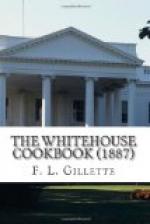FRIED VENISON STEAK.
Cut a breast of venison into steaks; make a quarter of a pound of butter hot in a pan; rub the steaks over with a mixture of a little salt and pepper; dip them in wheat flour, or rolled crackers, and fry a rich brown; when both sides are done, take them up on a dish, and put a tin cover over; dredge a heaping teaspoonful of flour into the butter in the pan, stir it with a spoon until it is brown, without burning; put to it a small teacupful of boiling water, with a tablespoonful of currant jelly dissolved into it; stir it for a few minutes, then strain it over the meat and serve. A glass of wine, with a tablespoonful of white sugar dissolved in it, may be used for the gravy, instead of the jelly and water. Venison may be boiled, and served with boiled vegetables, pickled beets, etc., and sauce.
[Illustration]
MEATS.
In the selection of meat it is most essential that we understand how to choose it; in beef it should be a smooth, fine grain, of a clear bright red color, the fat white, and will feel tender when pinched with the fingers. Will also have abundant kidney fat or suet. The most choice pieces for roast are the sirloin, fore and middle ribs.
Veal, to be good, should have the flesh firm and dry, fine grained and of a delicate pinkish color, and plenty of kidney fat; the joints stiff.
Mutton is good when the flesh is a bright red, firm and juicy and a close grain, the fat firm and white.
Pork, if young, the lean will break on being pinched smooth when nipped with the fingers, also the skin will break and dent; if the rind is rough and hard it is old.
In roasting meat, allow from fifteen to twenty minutes to the pound, which will vary according to the thickness of the roast. A great deal of the success in roasting depends on the heat and goodness of the fire; if put into a cool oven it loses its juices, and the result is a tough, tasteless roast; whereas, if the oven is of the proper heat, it immediately sears up the pores of the meat and the juices are retained.
The oven should be the hottest when the meat is put into it, in order to quickly crisp the surface and close the pores of the meat, thereby confining its natural juices. If the oven is too hot to hold the hand in for only a moment, then it is right to receive the meat. The roast should first be washed in pure water, then wiped dry with a clean dry cloth, placed in a baking pan without any seasoning; some pieces of suet or cold drippings laid under it, but no water should be put into the pan, for this would have a tendency to soften the outside of the meat. The water can never get so hot as the hot fat upon the surface of the meat, and the generating of the steam prevents its crispness, so desirable in a roast.




